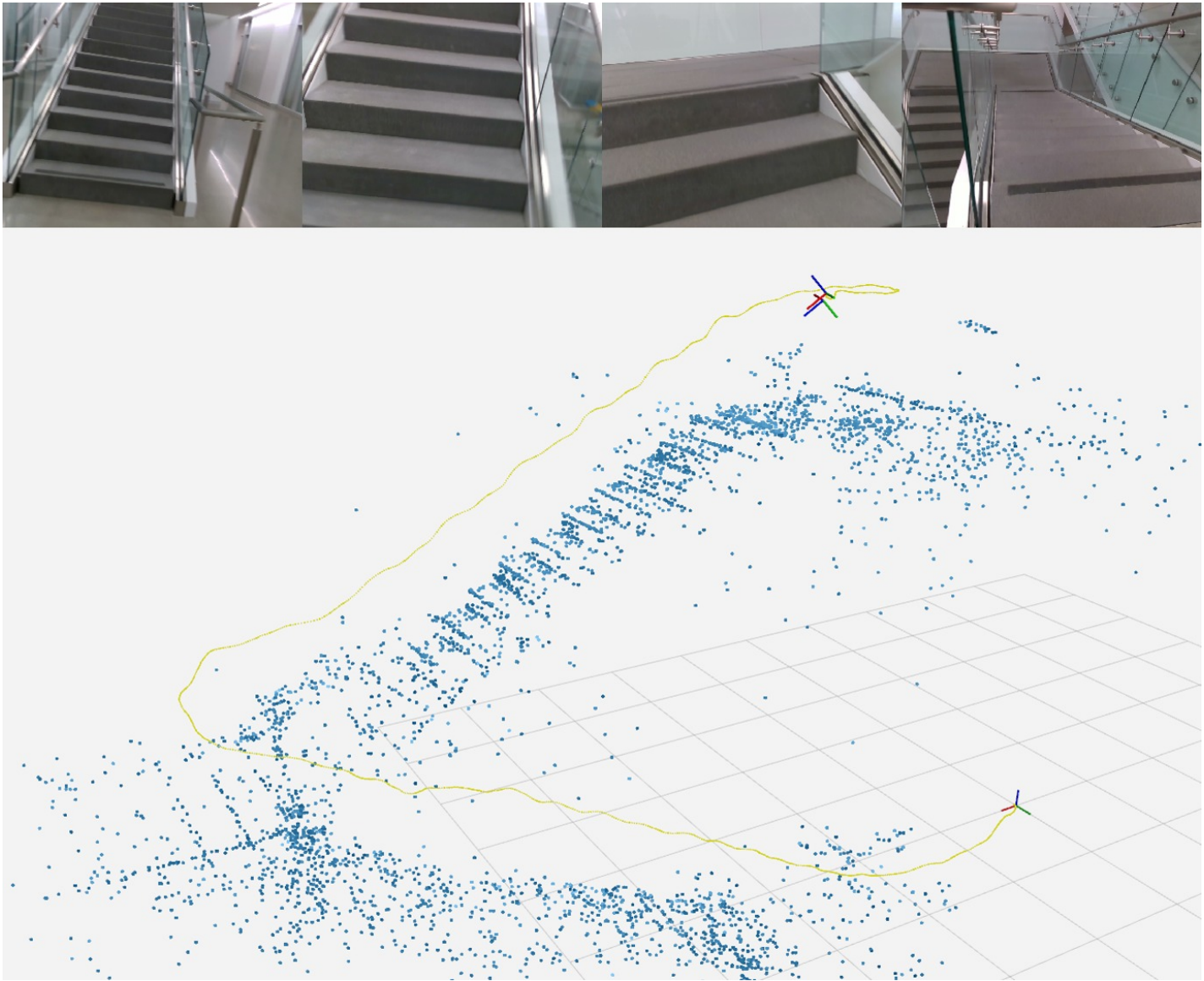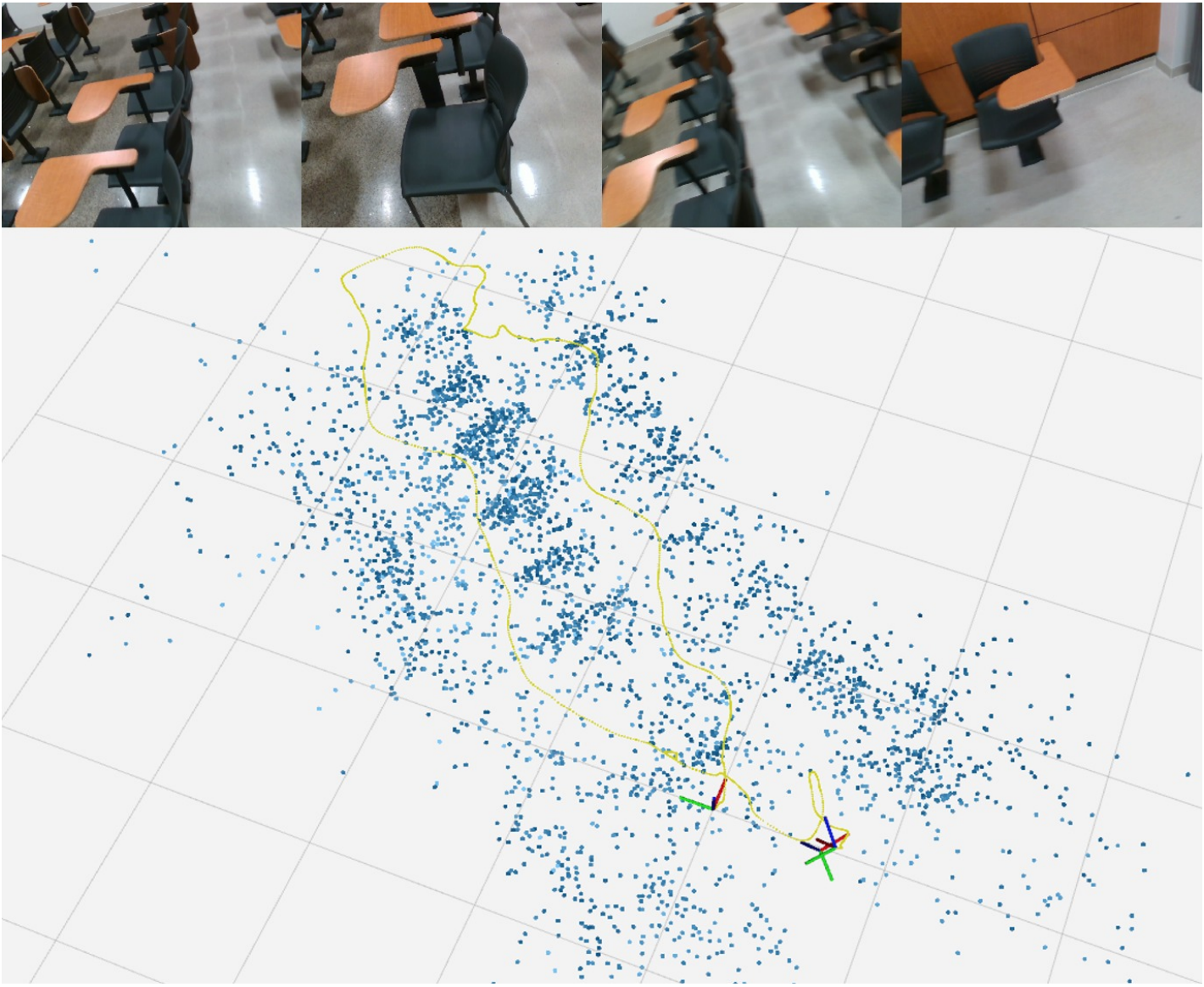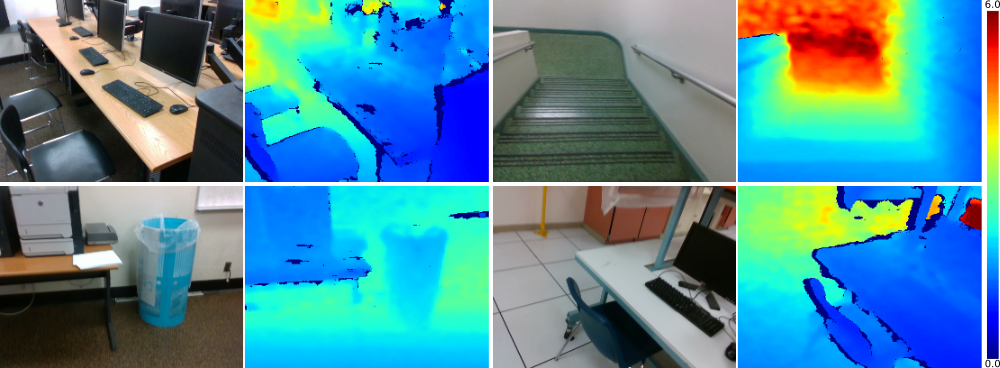Visual Odometry with Inertial and Depth (VOID) dataset
from Unsupervised Depth Completion from Visual Inertial Odometry (in RA-L January 2020 & ICRA 2020)
Authors: Alex Wong, Xiaohan Fei, Stephanie Tsuei
If you use this dataset, please cite our paper:
@article{wong2020unsupervised,
title={Unsupervised Depth Completion From Visual Inertial Odometry},
author={Wong, Alex and Fei, Xiaohan and Tsuei, Stephanie and Soatto, Stefano},
journal={IEEE Robotics and Automation Letters},
volume={5},
number={2},
pages={1899--1906},
year={2020},
publisher={IEEE}
}
To follow the VOID sparse-to-dense-depth completion benchmark, please visit: Awesome State of Depth Completion
We propose the VOID dataset for real world use case of depth completion by bootstrapping sparse reconstruction in metric}* space from a VIO system (XIVO).
The dataset was collected using the Intel RealSense D435i camera, which was configured to produce synchronized accelerometer and gyroscope measurements at 400 Hz, along with synchronized VGA-size (640 x 480) RGB and depth streams at 30 Hz. The depth frames are acquired using active stereo and is aligned to the RGB frame using the sensor factory calibration. All the measurements are timestamped.
The dataset contains 56 sequences in total, both indoor and outdoor with challenging motion. Typical scenes include classrooms, offices, stairwells, laboratories, and gardens. Of the 56 sequences, 48 sequences (approximately 47K frames) are designated for training and 8 sequences for testing, from which we sampled 800 frames to construct the testing set. Each sequence constains sparse depth maps at three density levels, 1500, 500 and 150 points, corresponding to 0.5%, 0.15% and 0.05% of VGA size.
| Staircase | Classroom |
|---|---|
 |
 |
For the release version of the dataset:
void_release
|---- <density>
|---- data
|---- <sequence>
|---- image
|---- <timestamp>.png
|---- ...
|---- sparse_depth
|---- <timestamp>.png
|---- ...
|---- validity_map
|---- <timestamp>.png
|---- ...
|---- ground_truth
|---- <timestamp>.png
|---- ...
|---- absolute_pose
|---- <timestamp>.txt
|---- ...
|----K.txt
|---- ...
|---- train_image.txt
|---- train_sparse_depth.txt
|---- train_validity_map.txt
|---- train_ground_truth.txt
|---- train_absolute_pose.txt
|---- train_intrinsics.txt
|---- test_image.txt
|---- test_sparse_depth.txt
|---- test_validity_map.txt
|---- test_ground_truth.txt
|---- test_absolute_pose.txt
|---- test_intrinsics.txt
|---- ...
Densities include 150, 500, and 1500 points, corresponding to the directories void_150, void_500, void_1500, respectively. Text files prefixed with train and test contains the paths for the training and testing sets.
For the raw dataset (rosbags):
void_raw
|---- <sequence>
|---- dataset
|---- dataset_500
|---- dataset_1500
|---- raw.bag
|---- ...
Files prefixed with dataset are the output of XIVO. The dataset file without the density suffix (``dataset'') denotes the dataset file for 150 points.
We will create a virtual environment with the necessary dependencies
virtualenv -p /usr/bin/python3 void-py3env
source void-py3env/bin/activate
pip install numpy opencv-python Pillow matplotlib gdown
This is only necessary for processing the raw dataset (rosbag). You may skip this step if you plan on only using the release version.
To install ROS Kinetic:
sudo sh -c 'echo "deb http://packages.ros.org/ros/ubuntu $(lsb_release -sc) main" > /etc/apt/sources.list.d/ros-latest.list'
sudo apt-key adv --keyserver 'hkp://keyserver.ubuntu.com:80' --recv-key C1CF6E31E6BADE8868B172B4F42ED6FBAB17C654
sudo apt-get update
sudo apt-get install ros-kinetic-desktop-full
To install build packages
sudo apt install python-rosinstall python-rosinstall-generator python-wstool build-essential
To enable your ROS environment:
source /opt/ros/kinetic/setup.bash
To download VOID dataset release version using gdown:
bash bash/setup_dataset_void.sh
Note: gdown intermittently fails and will complain about permissions
As a workaround you may directly download the dataset by visiting:
https://drive.google.com/open?id=1GGov8MaBKCEcJEXxY8qrh8Ldt2mErtWs
https://drive.google.com/open?id=1c3PxnOE0N8tgkvTgPbnUZXS6ekv7pd80
https://drive.google.com/open?id=14PdJggr2PVJ6uArm9IWlhSHO2y3Q658v
which will give you three files void_150.zip, void_500.zip, void_1500.zip
Assuming you are in the root of the repository, to construct the same dataset structure as the setup script above:
mkdir void_release
unzip -o void_150.zip -d void_release/
unzip -o void_500.zip -d void_release/
unzip -o void_1500.zip -d void_release/
bash bash/setup_dataset_void.sh unpack-only
To download the raw VOID dataset (rosbag) using gdown:
bash bash/setup_dataset_void_raw.sh
Note: gdown intermittently fails and will complain about permissions
As a workaround you may directly download the dataset by visiting:
https://drive.google.com/open?id=19uHUtjUnsZ2zhGPYJ--8xNN1kqpi_uaJ
which will give you void_raw.zip
Assuming you are in the root of the repository, to construct the same dataset structure as the setup script above:
mkdir void_raw
unzip -o void_raw.zip -d void_raw/
bash bash/setup_dataset_void_raw.sh unpack-only
To load depth and validity map filepaths:
import data_utils
train_sparse_depth_filepath = 'data/void_1500/train_image.txt'
train_validity_map_filepath = 'data/void_1500/train_image.txt'
train_sparse_depth_paths = data_utils.load_paths(train_sparse_depth_filepath)
train_validity_paths = data_utils.load_paths(train_sparse_depth_filepath)
To load depth and validity maps:
sparse_depth = data_utils.load_depth(train_sparse_depth_paths[0])
validity_map = data_utils.load_validity_map(train_validity_map_paths[0])
To store depth and validity maps:
sparse_depth_outpath = 'sparse_depth.png'
validity_map_outpath = 'validity_map.png'
data_utils.save_depth(sparse_depth)
data_utils.save_validity_map(validity_map)
To read intrinsics or pose (both are store as numpy text files):
import numpy as np
K = np.loadtxt('K.txt')
You may also find the following projects useful:
- VOICED: Unsupervised Depth Completion from Visual Inertial Odometry. An unsupervised sparse-to-dense depth completion method developed by the authors, published in the Robotics and Automation Letters (RA-L) 2020 and the International Conference on Robotics and Automation (ICRA) 2020.
- XIVO: The Visual-Inertial Odometry system developed at UCLA Vision Lab. The dataset files (e.g. sparse points, absolute poses) in VOID are produced by XIVO.
- GeoSup: Geo-Supervised Visual Depth Prediction. A single image depth prediction method developed by the authors, published in the Robotics and Automation Letters (RA-L) 2019 and the International Conference on Robotics and Automation (ICRA) 2019. This work was awarded Best Paper in Robot Vision at ICRA 2019.
This software is property of the UC Regents, and is provided free of charge for research purposes only. It comes with no warranties, expressed or implied, according to these terms and conditions. For commercial use, please contact UCLA TDG.
